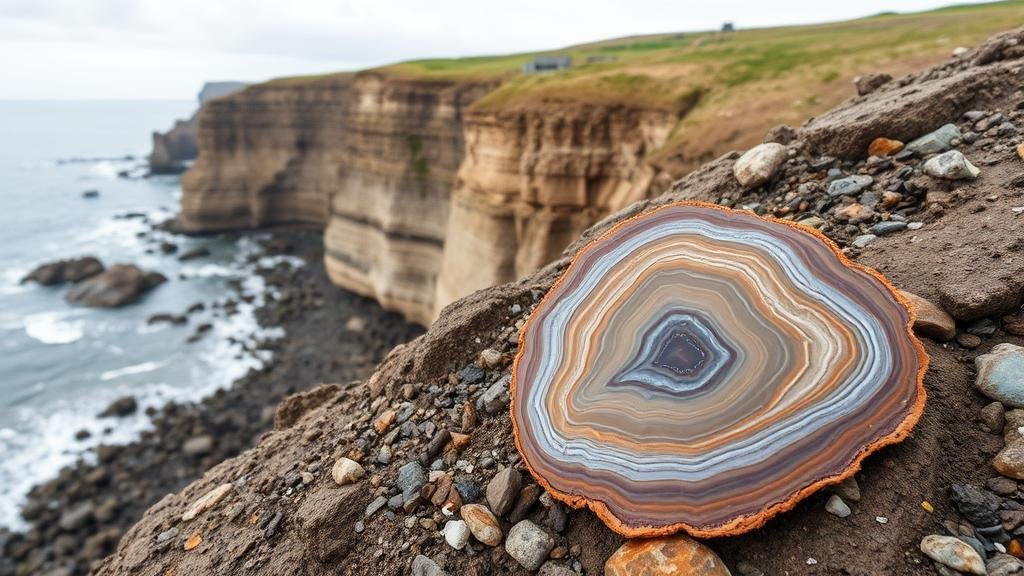Unearthing agates along the cliffs of Scotland’s Angus coastline, prized for their unique banding.
Unearthing Agates Along Scotland’s Angus Coastline
The Angus coastline of Scotland is not only a breathtaking stretch of natural beauty but also a hidden treasure trove for rockhounds and mineral collectors. Among its alluring offerings, agates stand out for their unique banding and striking colors, making them prized specimens for both enthusiasts and professionals alike.
Understanding Agates: A Geological Perspective
Agates are a form of chalcedony, which is a microcrystalline variety of quartz. They typically form within volcanic rocks and are characterized by their colorful, banded appearance. unique banding results from the deposition of silica in layers, leading to stunning coloration and patterns. The Angus coastline is especially rich in such formations due to its volcanic geology.
For those collecting agates, the Angus coast presents a variety of types, including:
- Fortification Agate: Exhibiting sharp, angular bands.
- Botryoidal Agate: Known for its spherical growth patterns.
- Ocean Agate: Characterized by soft, wavy lines resembling ocean waves.
Geological Formation and Location
The geology of the Angus coastline is primarily composed of Old Red Sandstone, along with volcanic rock formations. The repeated volcanic activity in this region contributed to the formation of agates. best locations for finding agates are the beaches and cliff faces where erosion has exposed these hidden gems. Cliffs in areas like Dunnottar Castle provide perfect conditions for rockhounding, as they are frequently weathered by the sea’s relentless crashing waves.
Optimal Conditions for Rockhounding
Timing and technique can significantly enhance your success in finding agates along the Angus coastline. Here are some practical tips for collectors:
- Best Time to Visit: Early morning or late afternoon during low tide offers the best visibility and access.
- Weather Conditions: Post-storm conditions can uncover new agates as strong waves can wash away sand and debris.
- Equipment: Bring a sturdy pair of gloves, a small rock hammer, and containers for storage.
Identification and Evaluation
Visually identifying agates can be straightforward once you know what to look for. Key characteristics include:
- Banded Patterns: Look for distinct layers of color within the stone.
- Hardness: Agates have a Mohs hardness of 6.5 to 7, making them relatively durable. A scratch test can help identify genuine agates from other stones.
- Translucency: Hold the stone up to the light; genuine agates will often show some degree of translucency.
Ecological Considerations and Conservation
While collecting agates can be an exciting hobby, it is essential to approach it responsibly. Adhere to local regulations regarding rockhounding, especially in designated conservation areas. Collect only what you need and ensure you leave no trace behind. This practice not only preserves the natural habitat but also ensures that future generations can experience the thrill of finding these beautiful stones.
Real-World Applications of Agate
Agates are more than just beautiful specimens; they hold significant value in various industries. Their unique properties make them popular in:
- Jewelry Making: Polished agates are frequently used in pendants, rings, and earrings.
- Decorative Arts: Larger specimens are often showcased in homes as striking display pieces.
- Healing Practices: In crystal healing, agates are believed to promote balance and harmony.
Conclusion: The Joy of Collecting Agates
Unearthing agates along the cliffs of Scotlands Angus coastline is an enriching experience that combines the thrill of discovery with the appreciation for geological beauty. Whether youre a seasoned rockhound or a curious beginner, the coast promises a rewarding adventure. Remember to respect the environment, treasure your finds, and enjoy the art of rock collecting in this unique and picturesque locale.



